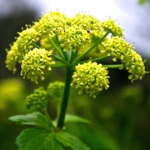Smyrnium olusatrum
Alexanders Αγριοσέλινο

Apiaceae - carrot family Monocot.
Smyrnium olusatrum
Alexanders Αγριοσέλινο

Apiaceae - carrot family Monocot.
Smyrnium olusatrum is a wayside plant with origins in the Mediterranean region but it has naturalised throughout Europe, as far north as Scotland; it is abundant in Skopelos, growing in orchards and olive groves as well as waste ground. The plant is biennial, producing abundant bright green, shiny leaves in the first year and developing into tall, geometric plants with rounded heads of creamy white flowers which are followed by black shiny seed heads, in the second year.
The scientific name of the genus comes from the ancient Greek, smyrna, meaning myrrh, because of the fragrant odour of the sap. Theophrastus described the curious belief that where myrrh was sprinkled, alexanders would grow.

Culinary uses of Alexanders
Αγριοσέλινο
Smyrnium olusatrum
Recognised since ancient times as a herb with health giving properties, Smyrnium olusatrum has recently been confirmed as a rich source of essential oils; the researchers describing it as a "lost vegetable".1 It has, however, not been forgotten in Skopelos, where it is collected by the islanders.
All parts of the plant are edible: the fresh young leaves are eaten as salad, older leaves boiled and served with olive oil dressing, blanched stems can be eaten like asparagus, the roots are boiled, and the black seeds used as a peppery spice. The young flower buds, dipped in batter and fried make delicate fritters.
Alexanders were introduced by the Romans to Northern Europe, where they later became a common pot-herb, grown in monastery gardens but their popularity declined in favour of celery. With the new trend in foraging, they may become popular again.
1. Phillipo Maggie et al.A forgotten vegetable (Smyrnium olusatrum L., Apiaceae) as a rich source of isofuranodiene. FOOD CHEMISTRY. 2012.
smyrna (σμύρνα) = myrrh + olus - potherb + atrum - black


